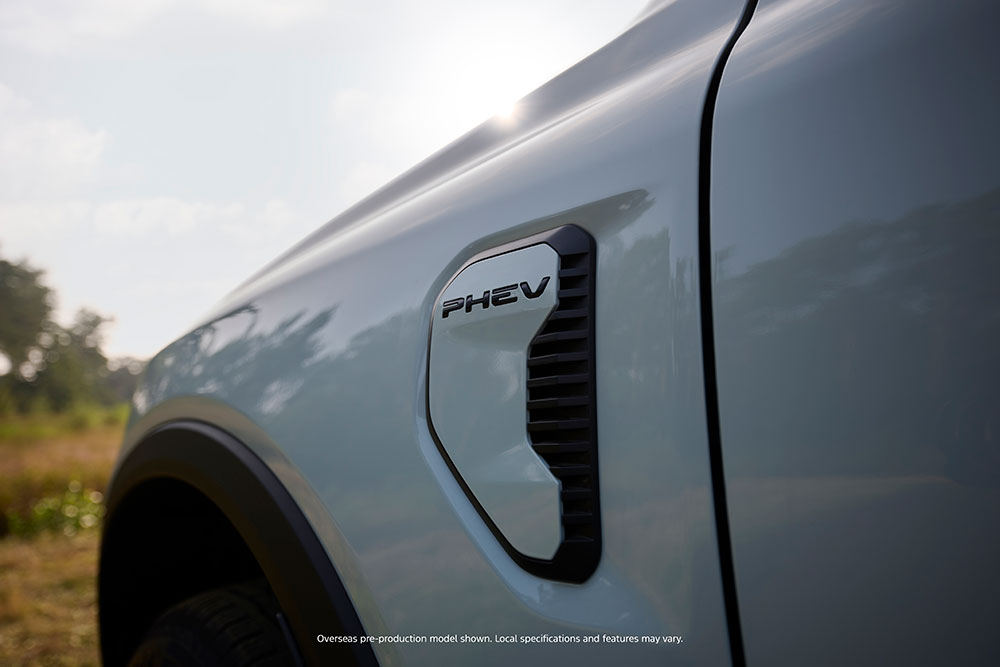Premium price for Ford Ranger PHEV ute
Ford Australia has confirmed pricing and specifications for its much-anticipated Ranger PHEV.
.jpg?h=667&iar=0&w=1000&rev=8de7f352f4f74bdb939d548049d18f52&hash=7D3F3B618F6DFB32208F4B2DE6127CB7)
Quick links
Ford Australia has confirmed pricing and specifications for its Ranger plug-in hybrid electric (PHEV) ute with the four-variant line-set to start from $71,990 when it launches here mid-year.
Pricing starts at $71,990 for the XLT, rises to $75,990 for the Ranger PHEV Sport, $79,990 for the Ranger PHEV Wildtrak, and tops out at $86,990 for the launch edition Ranger PHEV Stormtrak.
Pricing comparison
The price of the new Ranger PHEV is well north of the BYD Shark 6 which beat Ford to the punch by launching Australia’s first PHEV ute earlier this year priced at $57,900 (plus on-road costs).
It’s also more expensive than the recently launched Cannon Alpha PHEV which is priced between $63,990 and $68,990 driveaway.
But Ford is confident that the Ranger, which has been Australia’s best-selling ute for the past two years, has the reputation, technology and backing of its nationwide dealer network to win over fleet and private buyers, despite its higher price.
Powertrain and outputs
The PHEV variant introduces a fifth powertrain option to the Ranger lineup, with a 2.3-litre turbocharged four-cylinder EcoBoost petrol engine that Ford says is tuned for optimised hybrid efficiency to produce 138kW at 4600rpm, and 411Nm at 2700rpm.
The combustion engine mates with a 75kW electric motor (e-motor) and 11.8kWh (usable) battery, with the combination driving through a 10-speed automatic gearbox to deliver what Ford says is the off-road and towing capability customers in this segment require.
.jpg?rev=23dc9b03c0cf445ab3facc50ff7a239e&hash=F934B8CD959C7CD54D925883EDA612BB)
Combining both the combustion and electric power results in total system outputs of 207kW at 4,600rpm, and 697Nm at 2,500rpm, which means the Ranger PHEV boasts more power and torque than the 184kW/600Nm 3.0-litre V6 diesel engine used elsewhere in the range.
The new petrol-electric variant also produces more torque than the 3.0-litre twin-turbo V6 fitted to the Ranger Raptor, although the Raptor’s 292kW of power still trumps the PHEV.
Key rival the BYD Shark 6 combines a 1.5-litre turbo-petrol engine and single-speed automatic transmission with two electric motors – one powering each axle – and draws its power from a 29.58kWh LFP battery.
Charging, range and capability
The combination delivers combined outputs of 321kW/650Nm, up to 80km of pure electric range, combined-cycle fuel-consumption of 2.0L/100km and total driving range of 800km.
The Ranger PHEV, meanwhile, boast 49km of pure electric drive and combined cycle fuel consumption of 2.9L/100km, although Ford has stopped short of quoting a total combined range for its new ute at this stage.
A new Modular Hybrid Transmission (MHT) integrates Ranger PHEV’s e-motor between the engine and transmission, allowing hybrid driving.
The traction battery is packaged between specially engineered frame rails with the battery able to be fully charged overnight using a standard household plug.
.jpg?rev=89e9c707fe0e4088bdf3bb6897af9d1e&hash=4F412E14D2CEED31C97E64BBCC5F4DD6)
The Ranger’s maximum charge rate of 3.5kW AC means it can charge from 0-100% in 4 hours on a 3.5kW (15A@230kW) charger, or 6 hours 53 minutes on a 2.3kW (10A@230V) charge.
The BYD Shark 6 can charge at up to 7kW AC in around five hours, but can also charge at up to 55kW on a DC fast charger, which can charge the battery from 30% to 80% in about 25 minutes.
While the Shark 6 looks to have the Ranger PHEV’s measure in several areas, Ford’s trump card is the fact the Ranger PHEV maintains the ICE-powered Ranger’s full 3,500kg braked towing capacity, where the BYD ute is rated to tow just 2,500kg.
The Ranger PHEV also has a payload, or carrying capacity, advantage over its rival, with the entry-grade XLT boasting a 973kg of payload compared to 790kg for the BYD Shark 6, although this falls to just 808kg in the heavier and better equipped Ranger PHEV Stormtrak.
A unique load box design also means the Ranger PHEV’s tray is longer at 1,638mm than its regular Ranger stablemates and can accommodate two European pallets, where the Shark 6 has a shorter 1,520mm long tray that is also slightly narrower.
Ford is also claiming a likely off-road capability advantage over the BYD courtesy of its MHT setup which it says allows the Ranger PHEV to benefit from the same go-anywhere abilities as the existing Ranger lineup.
Like its 3.0-litre V6-powered turbodiesel stablemates, the Ranger PHEV utilises a full-time 4WD system with an electronically controlled two-speed transfer case offering drivers the choice of 2H, 4A, 4H, and 4L driving modes.
The Ranger PHEV also features a locking rear differential for additional off-road capability in rough terrain.
This should give Ford PHEV a handy off-road advantage over the Shark 6, which has no mechanical connection between its front and rear axles and no cross-axle differential locks, instead relying on electronic traction control systems to deliver its all-wheel drive.
.jpg?rev=ab118241135c4f41b9bca2a5db6b39ed&hash=DED8DF3196CF796D60130897CACF257E)
Vehicle to Load system
Another handy feature of the Ranger PHEV is its Pro Power Onboard system with every variant equipped with a 6.9kW V2L (Vehicle to Load) system.
The system uses the 11.8kWh traction battery to provide energy to power worksite equipment, campsites, or even a caravan directly from twin 15-amp, 3.45kW power sockets in the tray, and a single 10-amp, 2.3kW socket in the cabin.
“Pro Power Onboard is a game changer for Ranger owners,” said Chief Program Engineer, Ford Ranger PHEV, Phil Millar.
“Now instead of having to carry a heavy generator or batteries that take up precious room and can often be very noisy, a Ranger PHEV owner can plug virtually anything they might want to power directly into the vehicle itself.”
EV drive modes
Drivers can choose when to use the Ranger’s electric driving capability via an ‘EV’ button in the centre console which allows drivers to select from four EV drive modes.
In ‘Auto EV’ the Ranger PHEV chooses between the combustion engine and battery to prioritise maximum power or efficiency.
‘EV Now’ gives drivers the option to drive on battery power alone, providing maximum fuel saving.

‘EV Later’ prioritises the combustion engine to maintain the Ranger’s current state of charge, such as when you might be headed to a worksite or campsite and wanting to save the battery to use the Pro Power Onboard feature.
Finally, ‘EV Charge’ turns the combustion engine into a generator to help put juice back into the battery, which might be handy if camped up for several days and wanting to use Pro Power Onboard feature to power appliances.
The Shark 6 also boasts similar V2L capability but comes only in a single high-spec Premium trim, while the Ranger PHEV will be offered in four dual-cab 4x4 ute variants; XLT, Sport, Wildtrak, and Stormtrak.
President and CEO Ford Australia Andew Birkic said the Ranger PHEV was just the tip of the spear for the company’s commercial EV line-up, with the E-Transit Custom and Transit Custom PHEV set to join the existing E-Transit van in the coming months.
“Our Aussie engineering and design team have created a plug-in hybrid that allows diesel ute buyers to begin their electrification journey without sacrificing any of the core capability that they need from a truck – whether they use it for work or play,” Mr Birkic said.
The Ranger PHEV pricing details arrive at a time when the Federal Government is under pressure from some quarters to overturn its decision to roll back the fringe benefits tax (FBT) exemption for the vehicles from 1 April.
The FBT exemption was introduced in 2022 to encourage greater EV adoption and included PHEVs, but in October last year the government announced PHEVs would no longer be considered a zero or low-emissions vehicle under FBT law and wouldn’t be eligible for the electric car exemption after 1 April.
Related topics
Things to note
The information in this article has been prepared for general information purposes only and is not intended as legal advice or specific advice to any particular person. Any advice contained in the document is general advice, not intended as legal advice or professional advice and does not take into account any person’s particular circumstances. Before acting on anything based on this advice you should consider its appropriateness to you, having regard to your objectives and needs.
Insurance Products (excluding Travel Insurance) are issued by RACQ Insurance Limited ABN 50 009 704 152 (RACQI) and arranged by its agent, RACQ Distribution Services Pty Ltd (RDS) ABN 35 116 361 650, AFSL 567130 and RDS' authorised representatives (including RACQ Operations Pty Ltd ABN 80 009 663 414, AR No. 234978 (RACQO). Conditions, limits and exclusions apply. RDS and RACQO are in the RACQ group of companies. One of the companies in the RACQ group of companies has a minority shareholding in RACQI.
RDS and RACQO have not taken your personal objectives, circumstances or needs into account when preparing advice regarding insurance products and you will need to consider whether the advice is appropriate for you. Read the Product Disclosure Statement (PDS) and any applicable Supplementary PDS before making a purchase decision on this product. You can also access our Target Market Determinations on this website. RDS receives a commission from RACQI for the policies it arranges. RACQO receives fees paid for services it provides to RDS. Further details about remuneration are available on request prior to purchasing.
Banking and loan products issued by Members Banking Group Limited ABN 83 087 651 054 AFSL/Australian credit licence 241195 trading as RACQ Bank. Terms, conditions, fees, charges and lending policies apply. This is general advice only and may not be right for you. This information does not take your personal objectives, circumstances or needs into account. Read the disclosure documents for your selected product or service, including the Financial Services Guide and the Terms and Conditions, and consider if appropriate for you before deciding.
Except for RACQ Bank, any RACQ entity referred to on this page is not an authorised deposit-taking institution for the purposes of the Banking Act 1959 (Cth). That entity’s obligations do not represent deposits or other liabilities of RACQ Bank. RACQ Bank does not guarantee or otherwise provide assurance in respect of the obligations of that entity, unless noted otherwise.
RACQ Bank subscribes to the Customer Owned Banking Code of Practice which establishes higher standards than the law requires. The Code reflects modern consumer expectations and developments in approaches to issues such as consumer vulnerability, guarantors, and supporting customers through financial hardship. Please read our Customer Owned Banking Code of Practice page for more information.
RACQ Operations Pty Ltd (ABN 80 009 663 414 AR 000234978) and Members Travel Group Pty Ltd (ABN 45 144 538 803 AR 000432492) are acting as an Authorised Representative of the issuer of the insurance, Tokio Marine & Nichido Fire Insurance Co., Ltd. (ABN 80 000 438 291 AFSL 246 548). Any advice set out above is general in nature only, and does not take into account your objectives, financial situation or needs. Before purchasing any travel products, please consider the RACQ Travel Insurance Product Disclosure Statement (PDS) and the Target Market Determinations (TMDs) that apply to these products. Whilst the PDS outlines the Terms and Conditions of these products, the TMDs outline the intended class of customers that comprise the target market for these travel products. This will allow you to consider which products best suit your objectives, financial situation and needs and consider the products appropriateness to your personal circumstances. TMDs also outline matters involving the distribution and the review of these products. The PDS, Supplementary PDS and TMDs for each travel product can be found here.
